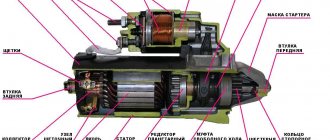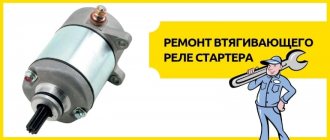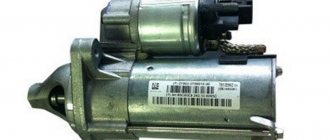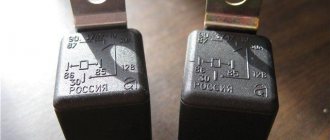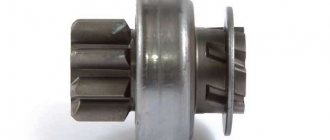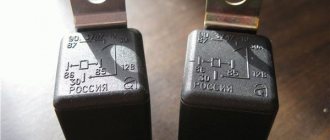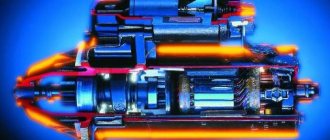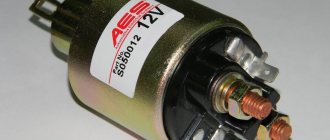As you know, in order to start a car engine, it is necessary to ignite the mixture of fuel and air in the combustion chambers of the cylinders. To do this, several conditions must operate synchronously, one of which is the rotation of the crankshaft. To spin it up at least at minimum speed, a converter of electrical energy into mechanical energy is used. This device is called the “starter”.
The design of the VAZ 2106 starter and the principle of its operation
They were not equipped with a starter with index 35.3708, and the very first models ST-221 were gear type. Export models were equipped with German-made devices. The diagram of this, in fact, power electric motor is shown in the photo.
- Drive shaft.
- Cover sleeve.
- Restrictor ring.
- Gear with overrunning clutch ring.
- Overrunning clutch roller.
- Support with liner.
- Gear axis.
- Pad.
- Drive arm bracket.
- Lever arm.
- Front cover.
- Traction relay rotor.
- Stator.
- Retractor stator.
- Traction relay.
- Relay rod.
- Relay core.
- Contact plate.
- Lid.
- Bolts for contacts.
- Brush assembly output.
- Brace.
- Brush holder.
- Plus brush.
- Rotor shaft.
- Hairpin for tie.
- Back cover.
- Collector.
- Aluminium case.
- Magnet with constant field.
- Rotor core.
- Rotor shaft support.
- Planetary gear.
- Drive gear.
- Driven.
- Gear with teeth inside.
- Retraction ring.
- Hub.
The rated power is 1.3 kW, current is 500 Ampere and 550 A for ST-221 and 35.3708, respectively.
The starter is an aluminum housing that contains a copper stator winding, a rotor, two covers (front and rear) and an electromagnetic type relay on top. The body is connected to the covers using studs. The stator has three serial winding poles (connected in series with the rotor winding) and one shunt-type winding, which is connected in parallel.
The armature is a core on the shaft, a copper winding and a platform for graphite brushes, called a commutator. The clutch is designed to transmit torque from the Bendix to the flywheel, then the crankshaft begins to rotate and the engine starts. After starting, it also serves to break the connection between the flywheel and the bendix. A traction relay consists of two windings and a core.
VESKO-TRANS.RU
Every driver faces a problem when his car breaks down and won't start. A necessary condition for this is often a faulty starter. It is a specific motor that uses a battery to power it.
Main malfunctions and their causes
The starter of the 6th VAZ model has standard equipment associated with other models of this brand. It follows that the malfunctions of these cars are similar.
Common starter errors:
- Relays and valves do not work.
- When switched on, only the electromagnetic relay is activated and the radial rotation of the valve is very slow or absent.
- When turned on, the crankshaft does not work.
- After starting the engine, the starter does not stop working.
- Excessive noise effects from the engine.
There are many circumstances under which the standard VAZ 2106 starter does not turn. Here are some of them:
- there is no battery charge indicator;
- common output circuit;
- the tightening force of the tips is weakened;
- the terminals of the ends of the wires or battery are oxidized;
- the mounting bolts are loose;
- brushes are worn out or hanging;
- burnt out collector;
- free sliding of wheels;
- the relay contacts have merged with each other;
- incorrectly installed starter;
- worn bushes or broken gear teeth and the like.
Troubleshooting after which the VAZ 2106 starter does not rotate
When understanding, it is important to pay attention to the following points:
- assess the condition of electronic power line contacts
- check the integrity of certain windings
- find out the availability of graphite brushes and their manufacture
- learn how bandix works and wears out
All internal engine components are often dirty. This could be dirt, dust, worn graphite, grease, insulation. This fact may also be a reason for its malfunction. This can also be the result of contact burns, wear of individual parts, failure of a special relay, or sticking brushes.
When disassembling the starter, it is necessary not only to eliminate the malfunction or breakdown, but also to clean it, and also check all engine parts.
It is important to check the functionality of the ammeter (normally no higher than 23 A) and voltmeter (no higher than 9 V). If the values exceed the norm, a short circuit may occur in the wiring. The tester must check the condition of the windings. Their coils must be dried and treated with insulating varnish. If there are scratches on the moving parts, remove them with sandpaper.
Keep in mind that manifolds with worn plates cannot be repaired. If the insulation is damaged, it is best to replace it, as well as any parts that are more durable than the specified specifications. If the thread is broken or damaged, you can return it with the last thread. If oxidized contacts are found, it is recommended to clean them.
After all repairs have been carried out, the equipment is assembled in the order specified in the instructions. It is ideal to check and clean the starter parts regularly. This way you can avoid serious damage in the future.
Starter operating principle
When the ignition key is turned to the “start” position, power is supplied to the traction relay, after which the core is pulled inward. When retracted by the fork, it moves the gear drive to the teeth of the engine flywheel, resulting in the starter engaging with the power plant. In parallel with this core, the contacts of the traction relay are closed, which in turn transmit power voltage to the stator windings.
A car starter is an electric motor designed for short-term operation. When starting the power unit, it is not recommended to hold the key in the ignition switch in the “start” position for more than 15 seconds. Between attempts to start the engine, the starter operation should be interrupted for 30–40 seconds (in winter, at least a minute). Operating the device for a long time will lead to overheating of the rotor and stator, as a result of which the varnish of the windings will begin to melt and, as a result, an interturn short circuit will occur or the windings will burn out.
If the engine does not start after three or more attempts, then there may be a malfunction in the systems (ignition, power, etc.) involved in starting the engine. You should not repeat attempts to start and operate the starter over and over again, as this will shorten its service life. After the engine starts, the ignition key must be immediately released to return it from the “start” position.
It is unacceptable to drive a car using torque from the starter; the device will quickly become unusable.
Which starter to buy for the “six”: selection of components
The stock version of the VAZ 2106 is equipped with a gear-type electric motor, the minimum power of which is 1.4 kW/h. The design of the “six” involves the installation of higher power models up to 1.6 kW/h to make it easier to start the engine in cold weather, but in this case it will be necessary to replace the power wiring.
| Manufacturer | vendor code | Part type | Device power, kW/h | Approximate cost, rub. |
| ZiT | 425.3708000 | Geared | 01.04.2019 | 3600 |
| ZiT | 425.3708023 | Geared | 01.05.2019 | 3990 |
| BATE | 2101-3708000 | Geared | 01.04.2019 | 3700 |
| BATE | 2101-3708023 | Geared | 01.06.2019 | 4500 |
| PRAMO-ELECTRO | 21214.3708010-81 | Geared | 01.04.2019 | 4100 |
| PRAMO-ELECTRO | 21214.3708010-34 | Geared | 01.05.2019 | 4700 |
| BULSTART | 2101-3701010 | Geared | 01.05.2019 | 4600 |
| BULSTART | 2101-3701023 | Geared | 01.06.2019 | 4900 |
Note! Before installing the starter, it is recommended to check the part for compatibility - the ideal option would be to check the part number indicated on the product packaging with the vehicle VIN code. Remember, installing an electric motor with increased power can negatively affect the operational life of the power unit or cause a short circuit and output of the vehicle’s electrical systems.
Starter malfunctions and their possible causes
Problems with operation are always associated with the complication or inability to start the engine. This device only works in conjunction with other starting and charging systems. Therefore, the causes of failures can be electrical and mechanical breakdowns, each of which has its own characteristics.
Electrical problems
Often, malfunctions are caused by faults in the electrical circuit, which starts with the battery. The main symptom is the slow rotation of the crankshaft at the time of starting the engine or its absence. First you need to check the following:
https://youtu.be/Y87CeE8GfSE
- battery charge;
- reliability of the “mass” and contacts;
- power wire to the traction relay for damage;
- serviceability of the ignition switch and its contacts.
If in the “start” position the relay does not operate and the rotor does not show signs of life, then an interturn short circuit, a short circuit to ground, or a broken connection to ground may have occurred. If the flywheel spins slowly, this also indirectly indicates electrical faults (the exception is the winter, when in severe frosts it is difficult for the starter to turn a frozen engine with thickened oil). When the starter starts to click characteristically, this may indicate a faulty relay or a low battery. If no problems are visually identified, then the device must be dismantled to disassemble and identify the causes of the breakdown.
Often the problem arises due to closed contact plates, commutator burning, but most often the brushes wear out. Therefore, you need to pay attention to the brush assembly, failure of the solenoid relay and worn-out rotor commutator.
Mechanical problems
Malfunctions can also occur for reasons related to mechanics. In most cases, this type of breakdown can be judged by special signs: the engine does not start and the crankshaft does not rotate, but the starter works. The reason for this may be a breakdown of the overrunning clutch (also called bendix), the flywheel crown, or wear of the drive gear.
Main symptoms of problems
| Malfunction | Causes |
| The starter works, but the engine crankshaft does not rotate. | The clutch slips; the shutdown lever is broken or jumping off; the buffer spring is broken; The coupling ring is badly worn. |
| A grinding noise when trying to start the engine and other extraneous sounds when the starter is operating. | Damage to gear teeth; the mounting bolts have become loose; bearings or their seats on the rotor are worn out; the fastening inside the starter has become loose, causing the stator and rotor to touch each other; The teeth of the flywheel or starter gear are worn. |
| The engine has started, the starter continues to operate. | The clutch spring is worn out, which is why the drive gear does not return to its place; relay contacts have become sour; the relay has failed; the drive is jammed. |
| The battery is charged, but the starter spins the engine with great difficulty. | Brushes or bearing worn. |
| The mechanism does not immediately disengage from the flywheel. | The gear teeth on the Bendix are worn out. |
The last two points should be paid attention to if the above reasons do not apply, and the starter still does not work as it should. All these signs will help you quickly identify and fix the malfunction of this device. In most cases, parts must be replaced, and in case of serious failures, such as interturn short circuit or winding damage, it is recommended to purchase a new unit.
Symptoms of malfunction
On such cars, starters 35.3708 are installed, on which the manifold is of the end-face type. This model is produced here in Germany or Belarus. Therefore, this immediately narrows the search for the required spare part by manufacturer. And as years of practice have shown, the most common diseases in a car, which indicate that the starter has given up its life:
- The solenoid relay does not work, but the starter continues to turn on. Possible reasons: a short circuit to ground, the tightening tips have become loose, the relay armature has begun to jam, one of the wires has broken or they have oxidized.
- The armature rotates, but the crankshaft stands still. Possible reasons: slipping of the clutch, displacement of the clutch to the side, there may also be a problem with the buffer spring.
- The starter itself turns poorly or does not turn at all, and the armature often does not work. Possible reasons: burnt collector contacts, insufficient battery charge, short circuit inside the collector plates.
- Starter noise. Possible causes: broken gear teeth, worn bushing.
- The starter does not complete its job. Possible reasons: soldered relay contacts, sagging spring, misalignment of the starter itself.
Replacing the starter on a VAZ 2106 with your own hands
In some cases, repair is no longer practical, so it must be replaced with a new one, and for this it must be removed from the car. This is not difficult to do; besides, you only need one key for 13. There are only two fastening bolts.
- After unscrewing the bolts, the starter must be moved to the right by pulling it in this direction. This way it will shift relative to its position, after which it can be moved to the right side even more.
- After this, the starter needs to be turned with the end part, lifted by the left side and pulled up towards you.
- It must be raised so that the power wires at the winding output contacts do not become accessible and can be disconnected.
- There are two wires on the starter; to disconnect one you need to unscrew the nut.
- The second is connected using male-female terminals; it can simply be disconnected by pulling the plug.
The starter can now be completely removed for replacement or repair. Installation is carried out in reverse order.
Starter repair: how to troubleshoot
To carry out the work you will need the following set of tools:
- box and socket wrenches (8, 10 and 13);
- screwdrivers;
- calipers;
- multimeter;
- pliers;
- hammer;
- mandrel for installing bearings;
- lubricants;
- abrasive materials (sandpaper).
There are many small parts in the starter; when disassembling you need to be careful not to lose them.
In order to eliminate the causes of mechanism breakdowns, it must, of course, be disassembled. The process looks like this:
- first you need to remove the traction relay by disconnecting the wires (unscrew the nut with a 13mm wrench) from the winding output;
- Unscrew the three relay mounting screws from below;
- the relay is pulled out and the rotor can be pulled out by removing the spring;
- Now you can remove the upper starter protection by unscrewing the screws securing the casing;
- using screwdrivers, you need to pry up the retaining ring and remove it together with the pressure washer;
- use a 10mm wrench to unscrew the two bolts that secure the cover;
- use a screwdriver to unscrew the fastening screws of the connecting wire;
- the cover is detached from the body;
- the brushes are removed along with the springs;
- Using a mandrel, the rear bearing must be pressed out, while being careful not to break the housing;
- use pliers to remove the cotter pin;
- remove the plug and the rotor with the fork;
- the bearing is pressed out from the front using a mandrel;
- the bendix can be dismantled (move the washer and remove the retaining ring using screwdrivers); in this matter you need to be more careful, since the ring may unexpectedly fly away in an unknown direction.
This completes the disassembly of the starter. You can proceed to identifying damage to eliminate it. Afterwards, the so-called troubleshooting is carried out, or, more simply, it is necessary to inspect each element of the mechanism.
Troubleshooting - visual inspection
When all the parts are in front of your eyes, you can find out by inspection which of them needs to be replaced.
- The height of the brushes is measured with a caliper. If the readings are less than 12 mm, then the brushes need to be replaced.
- The windings should not show signs of burning, signs of insulation damage or other mechanical damage.
- The armature shaft fits without much play. Otherwise, all worn elements will need to be replaced.
- If there are burn marks on the armature, they can be removed with fine-grit sandpaper.
- Grasp the inner and outer race of the bearing. This way the presence of play is checked. If it is detected, the bearing must be replaced.
- The teeth on the Bendix gear show no signs of wear, the gear should not rotate in both directions, otherwise the part needs to be replaced.
- Solenoid relay plug without mechanical damage.
If damaged parts are identified, they cannot be repaired. Replacement with new components will be required. They are inexpensive, and installation will not be difficult.
Features of mechanism diagnostics
The starting unit is checked using a tester. After turning on the device, the voltmeter reading should not be higher than 8V, and the current should not exceed 23A.
You can check the windings using a tester; if it lights up, it means there is a short circuit. To perform a visual inspection of the starting unit, it must be removed and cleaned of dirt (video author - Irina Kuzilova)
When disassembling the device, each part should be visually inspected. Scores and scratches can be removed using sandpaper. Broken and worn parts must be replaced. It is also necessary to replace the VAZ 2106 starter bushings if they are badly worn.
A faulty collector cannot be repaired; it is advisable to replace it. The height is checked on the brushes. More than 12 mm is considered optimal, otherwise the brushes must be replaced.

